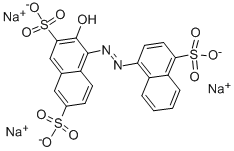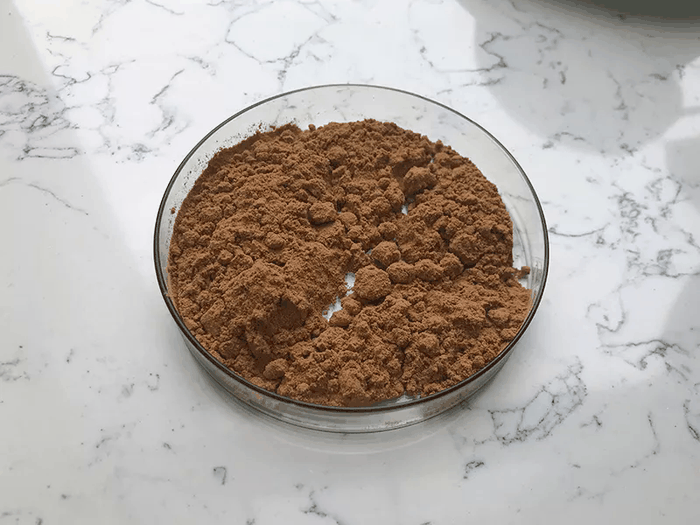Acid Red 27
Synonym(s):3-Hydroxy-4-[(4-sulfonatonaphthalen-1-yl)diazenyl]naphthalene-2,7-disulfonate trisodium salt;Acid Red 27;Azorubin S;FD & C Red Dye No. 2
- CAS NO.:915-67-3
- Empirical Formula: C20H11N2Na3O10S3
- Molecular Weight: 604.47
- MDL number: MFCD00004076
- EINECS: 213-022-2
- SAFETY DATA SHEET (SDS)
- Update Date: 2025-12-17 09:49:33

What is Acid Red 27?
Description
Amaranth (FD & C Red No. 2) consists essentially of a trisodium 2-hydroxy-l-(4-sulfonato-1-naphthy lazo)naphthalene 3,6-disulfonate and subsidiary coloring matters together with sodium chloride and/or sodium sulfate as the principal uncolored components. Amaranth may be converted to the corresponding aluminum lake.
Description
Amaranth is a tribasic sulfonate dye first prepared by O. Knecht in 1886. It became known as the infamous FD&C Red No. 2, which was used to add red color to foods and cosmetics—until it was banned by FDA in 1976 as a suspected carcinogen. It also is used to dye wool and silk and as an indicator in hydrazine titrations.
Chemical properties
solid
The Uses of Acid Red 27
Dyeing wool and silk bright bluish-red from an acid bath. Food colorant. As indicator. In color photography.
What are the applications of Application
Amaranth is a cytoplasmic and nuclear dye
Definition
An azo dye derived from naphthionic and R acids.
World Health Organization (WHO)
Approval of amaranth as a permitted colouring agent in foods and pharmaceutical products was withdrawn by the United States FDA in 1976, on the basis of positive findings in carcinogenicity tests which were later disputed on technical grounds and which have not been confirmed in subsequent tests. It has since been withdrawn by some other national regulatory authorities because of uncertainty regarding its safety, but elsewhere it remains widely used.
General Description
Dark red to dark purple powder. Almost no odor. Tastes salty. pH (1% solution in water) approximately 10.8. Used to dye wool and silk bright bluish-red from an acid bath.
Air & Water Reactions
Can be explosive as an airborne dust at certain concentrations. Moderately soluble in water.
Reactivity Profile
Acid Red 27 may form toxic gases with acids, aldehydes, amides, carbamates, cyanides, inorganic fluorides, halogenated organics, isocyanates, ketones, metals, nitrides, peroxides, phenols, epoxides, acyl halides, and strong oxidizing or reducing agents. May form flammable gases with alkali metals. Explosive combination can occur with strong oxidizing agents, metal salts, peroxides, and sulfides.
Hazard
A questionable carcinogen. May not be used in foods, drugs, or cosmetics.
Fire Hazard
Flash point data for Acid Red 27 are not available; however, Acid Red 27 is probably combustible.
Properties and Applications
|
Standard |
Light Fastness |
Soaping |
Persperation Fastness |
Oxygen bleaching |
Fastness to seawater |
|||
|
Fading |
Stain |
Fading |
Stain |
Fading |
Stain |
|||
|
ISO |
3 |
3 |
5 |
3-4 |
1 |
4-5 |
3 |
2 |
|
AATCC |
5 |
3 |
3 |
3-4 |
2 |
2 |
1 |
1 |
Properties of Acid Red 27
| Melting point: | >300°C |
| Density | 1.5 |
| storage temp. | Sealed in dry,Room Temperature |
| solubility | H2O: soluble10mg/mL |
| Colour Index | 16185 |
| form | Crystalline Powder |
| color | Dark reddish-brown to dark brown |
| Water Solubility | 50 g/L (20 ºC) |
| λmax | 520 nm |
| Merck | 14,375 |
| BRN | 4122311 |
| Stability: | Stable. Incompatible with strong oxidizing agents. |
| Biological Applications | Detecting membrane-potential change; treating acquired resistance to GABAergic (ARG) agents |
| CAS DataBase Reference | 915-67-3 |
| IARC | 3 (Vol. 8, Sup 7) 1987 |
| EPA Substance Registry System | C.I. Acid Red 27, trisodium salt (915-67-3) |
Safety information for Acid Red 27
| Signal word | Warning |
| Pictogram(s) |
 Exclamation Mark Irritant GHS07 |
| GHS Hazard Statements |
H319:Serious eye damage/eye irritation |
| Precautionary Statement Codes |
P264:Wash hands thoroughly after handling. P264:Wash skin thouroughly after handling. P280:Wear protective gloves/protective clothing/eye protection/face protection. P305+P351+P338:IF IN EYES: Rinse cautiously with water for several minutes. Remove contact lenses, if present and easy to do. Continuerinsing. P337+P313:IF eye irritation persists: Get medical advice/attention. |
Computed Descriptors for Acid Red 27
| InChIKey | WLDHEUZGFKACJH-ZRUFZDNISA-K |
Acid Red 27 manufacturer
New Products
4,4-Difluoropiperidine hydrochloride tert-butyl 9-methoxy-3-azaspiro[5.5]undecane-3-carboxylate Indole Methyl Resin N-Isopropylurea N,N-Dicyclohexylcarbodiimide(DCC) MELDRUMS ACID 5-METHYLISOXAZOLE-4-CARBOXYLIC ACID Magnessium Bis glycinate Zinc ascorbate 1-bromo-2-butyne 2-acetamidophenol 9(10H)-anthracenone Erythrosin B, 4-Piperidinopiperidine 2-((4-morpholinophenylamino) (methylthio) methylene) malononitrile 2,4-dihydroxybenzaldehyde 3-(4-morpholinophenylamino)-5-amino-1H-pyrazole-4-carbonitrile Methyl 2-methylquinoline-6-carboxylate 2,6-dichloro-4-nitropyridine 4-Bromo-2-chlorobenzonitrile 2-(benzylamino)acetic acid hydrochloride 4-(tert-Butoxycarbonylamino)but- 2-ynoic acid 3,4-dihydro-2H-benzo[b][1,4]dioxepine 1-Phenyl-1-cycloprppanecarboxylicacidRelated products of tetrahydrofuran



![(3-THIOPHEN-2-YLMETHYL-5-THIOXO-1,5-DIHYDRO-[1,2,4]TRIAZOL-4-YL)-ACETIC ACID](https://img.chemicalbook.in/CAS/GIF/4363-99-9.gif)




You may like
-
 Acid red 27 99%View Details
Acid red 27 99%View Details -
 Acid red 27 98%View Details
Acid red 27 98%View Details -
 Amaranth (Acid Red 27) (C.I. 16185) CAS 915-67-3View Details
Amaranth (Acid Red 27) (C.I. 16185) CAS 915-67-3View Details
915-67-3 -
 Amaranth CAS 915-67-3View Details
Amaranth CAS 915-67-3View Details
915-67-3 -
 Amaranth 500GRAM ALPHAView Details
Amaranth 500GRAM ALPHAView Details
915-67-3 -
 AMARANTH (C.I.NO. 16185)View Details
AMARANTH (C.I.NO. 16185)View Details
915-67-3 -
 Form: Powder AzorubinView Details
Form: Powder AzorubinView Details
3567-69-9 -
 AmaranthView Details
AmaranthView Details
915-67-3
